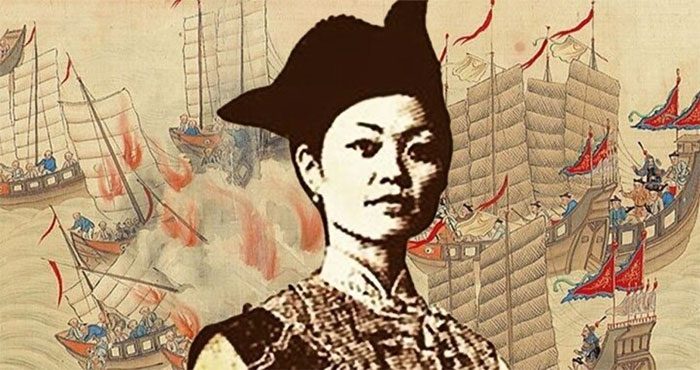From a Courtesan to a Notorious Pirate: Trịnh Thị Leads a Fearsome Band of Pirates in Southern Waters.
Trịnh Thị, born Thạch Tú Cô, in 1775 in Guangdong, Southern China, began her life as a courtesan in a brothel in Guangzhou. In 1801, she met Trịnh Nhất, the leader of the Red Flag Pirate Clan, and became his wife.
The Notorious Female Pirate
Under the management of Trịnh Nhất and his wife, the Red Flag Clan grew from 200 ships to 1,800 ships over six years, distinguishing their ranks by the colors red, black, white, blue, yellow, and green on their vessels. The Red Flag Clan also allied with the pirate group led by the Ngô family to form the Guangdong Pirate Alliance.

Portrait sketch of Trịnh Thị. (Image: Sohu).
In 1801, after Trịnh Nhất’s death—likely due to a storm at sea—the command of the fleet was handed over to Trương Bảo, his adopted son. However, shortly after, Trịnh Thị became Trương Bảo’s lover and effectively took command of the Red Flag Pirate Fleet, which boasted over 1,800 ships and around 50,000 crew members.
For comparison, the infamous Blackbeard, who lived during the same period, commanded only four ships and 300 pirates, while the U.S. Navy at that time consisted of merely 5,000 sailors.
To manage the fleet effectively, Trịnh Thị appointed Trương Bảo as the fleet captain while she took charge of the business and military strategy of the pirate army. Running such a large band of outlaws was no easy task. To unify the management of her fleet, Trịnh Thị established a set of rules applicable to all pirates under her command, along with strict laws to punish those who did not comply.
For instance, she decreed that any pirate disobeying orders would be beheaded on the spot. This female pirate also imposed harsh penalties like cutting off the ears of deserters and beating them with iron rods. All loot acquired had to be submitted to the fleet for equal distribution, with ships directly involved in piracy receiving only 20% of the value.
The code also included strict regulations on how to treat female prisoners. When capturing women from merchant ships, those of average looks would be immediately released, while beautiful girls were auctioned off to the pirates on board.
The buyer of a female prisoner was required to marry her and live with her for life; any deceit would result in execution. Pirates who raped female prisoners would also be executed on the ship, and if the pre-marital encounter was consensual, both parties would face the death penalty.
Trịnh Thị’s Red Flag Fleet terrorized the southern seas, reaching as far as Malaysia and even controlling several coastal villages from Macau to Guangzhou, imposing taxes on the local population.
Her pirate ships attacked and plundered indiscriminately, from Chinese merchant vessels to British and Portuguese naval ships. The Qing Dynasty repeatedly sent troops to combat her, with the Portuguese navy and East India Company ships joining the efforts, but all failed due to the overwhelming strength of the Red Flag Fleet.
A Manchu naval admiral reported to the dynasty, stating: “The pirates are too strong; we cannot control them by force.”
After three consecutive years of clashes at sea, the imperial troops still could not subdue Trịnh Thị’s pirate faction. However, divisions began to emerge within the pirate ranks, splitting into two factions: Red Flag and Black Flag. Under immense pressure from the imperial forces, the Black Flag faction surrendered. Recognizing that continued military action would not subdue Trịnh Thị, the Qing Dynasty opted for negotiation to persuade the female pirate to surrender in 1810.
Sheath the Sword and Retire
The Qing court dispatched the governor of Liangguang to negotiate with pirate leader Trương Bảo, but talks soon stalled as the Qing insisted the pirate leader must bow and submit to the imperial forces, along with disagreements regarding the distribution of the plundered wealth.

Illustration of Trịnh Thị fighting against the Qing court. (Image: Sohu).
Trịnh Thị decided to take matters into her own hands, entering the governor’s office unarmed with 17 women and children to negotiate. The two parties reached an agreement that allowed Trịnh Thị to retain all the plundered wealth in exchange for her submission to the Qing Dynasty.
The issue of bowing was resolved when Governor Liangguang officiated the wedding between Trịnh Thị and Trương Bảo, allowing the couple to kneel before him as a form of gratitude. At this point, Trịnh Thị’s pirate career came to an end.
After submitting to the Qing Dynasty, 126 members of her pirate crew were executed, 400 exiled, while the rest were either freed or conscripted into military service. Trịnh Thị and Trương Bảo had one child together.
Upon Trương Bảo’s death, Trịnh Thị returned to Guangzhou to open a gambling house, continuing her business until her death in 1844 at the age of 69.




















































